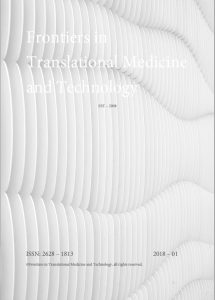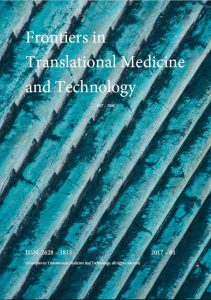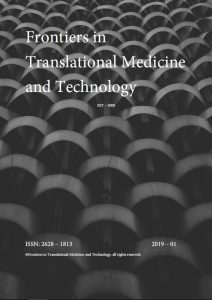We are going fully open access!
In the future we will only provide open access articles, as we think science should be accessed freely and major scientific outcomes should spread quickly. Share the word!
All articles of the first fully open access issue will be completely free of charge. Better hurry! Otherwise our very fair publication charge of 200€ in total for one article will apply.
Look here for guidelines regarding the manuscript preparation process and here for journal policies.
If you want to buy individual articles or issues, please send an e-mail with your desired issue or article to subscribe@frontiersmed.com.
Single Article: 20€
Single Issue: 50€
Subscription: Please ask for details
Issue 2019
- Engineering Approaches to Study Cellular Decision MakingPamela K. Kreeger, Laura E. Strong, and Kristyn S. Masters: In their native environment, cells are immersed in a complex milieu of biochemical and biophysical cues. These cues may include growth factors, the extracellular matrix, cell–cell contacts, stiffness, and topography, and they are responsible for regulating cellular behaviors such as adhesion, proliferation, migration, apoptosis, and differentiation. The decision-making process used to convert these extracellular inputs into actions is highly complex and sensitive to changes both in the type of individual cue (e.g., growth factor dose/level, timing) and in how these individual cues are combined (e.g., homotypic/heterotypic combinations). In this review, we highlight recent advances in the development of engineering-based approaches to study the cellular decision-making process. Specifically, we discuss the use of biomaterial platforms that enable controlled and tailored delivery of individual and combined cues, as well as the application of computational modeling to analyses of the complex cellular decision-making networks.
- Synthetic Biology: Immunotherapy by Design Matthew J. Brenner, Jang Hwan Cho, Nicole M.L. Wong, and Wilson W. Wong : Cellular immunotherapy holds great promise for the treatment of human disease. Clinical evidence suggests that T cell immunotherapies have the potential to combat cancers that evade traditional immunotherapy. Despite promising results, adverse effects leading to fatalities have left scientists seeking tighter control over these therapies, which is reflected in the growing body of synthetic biology literature focused on developing tightly controlled, context-independent parts. In addition, researchers are adapting these tools for other uses, such as for the treatment of autoimmune disease, HIV infection, and fungal interactions. We review this body of work and devote special attention to approaches that may lend themselves to the development of an “ideal” therapy: one that is safe, efficient, and easy to manufacture. We conclude with a look toward the future of immunotherapy: how synthetic biology can shift the paradigm from the treatment of disease to a focus on wellness and human health as a whole.
- Developing Personal Reflection and Collaboration in Translational Medicine Towards Patients and Unmet Medical Needs Moira Clay, LInda T. Hiraki: This perspective article aims to highlight the importance of values-driven personal reflection and collaboration for effective translational medicine training. We frame the dilemma in translational medicine and provide an approach for solution emphasizing collaboration and co-creation for innovative change in translational research. We cite the science in transition literature suggesting why personal reflection and a collaborative approach is important. We identify the problem with publication pressures and the bibliometric mindset. We focus on motivation to seek and find results that really matter for patients and individuals to maintain health in the real world. We review how the international EUREKA Institute for Translational Medicine (established in 2007) works with students, to harness their core values and develop personal growth skills to improve their leadership effectiveness, to work towards collaborative gain and potentially more meaningful results for patients and medical needs. We describe how the EUREKA Institute’s unique setting, curriculum and hidden curriculum aspects effectively train program participants. The article highlights creating an immersive safe space, personal reflection, connection, structured brainstorming, group problem solving, collaboration and co-creation to facilitate innovation in translational medicine. The article relates program features to their theoretical underpinnings such as Theory U, Mediation Theory and Strategic Innovation Theory. The six authors from different global regions, ages, career stages, translational research contexts and years of attendance at the EUREKA Institute provide their reflections on training impact. Lessons learned and recommendations for research and application are discussed.
- Selection of a Real-Time PCR Housekeeping Gene Panel in Human Endothelial Colony Forming Cells for Cellular Senescence Studies Kiran J. McLoughlin, Edoardo Pedrini, Meabh MacMahon, Jasenka Guduric-Fuchs and Reinhold J. Medina: Endothelial Colony Forming Cells (ECFCs) represent a subset of endothelial progenitors with well-documented vasoreparative capacity. However, cellular senescence, which occurs due to aging, diabetes, smoking, or tissue inflammation, renders these cells dysfunctional. Therefore, there is growing interest in studying expression of senescence markers in ECFCs. RT-qPCR is the most commonly used technique to quantify gene expression and the proper choice of reference genes used for data normalization is critical for accurate quantification. It has been reported that the expression of commonly used housekeeping genes is often unstable in senescence. To identify the most suitable reference genes for ECFC senescence studies, we analyzed a microarray dataset, which compared the gene expression between proliferating and senescent ECFCs. In addition to replicative senescence, the data included X-ray-induced and Etoposide-induced senescence. We used the geNorm algorithm to identify the most stable genes across all studied conditions. Gene Ontology analysis found that the most stable genes belonged to the KEGG category of Genetic Information Processing. The optimal combination of housekeeping genes for ECFC senescence was found to include four ribosomal protein genes; RPL13, RPL31, RPL37, and RPL30. The RT-qPCR validation confirmed that normalization with our novel panel was more sensitive in identifying senescence markers compared to commonly used genes such as ACTB, UBC, and GAPDH.
- Additive manufacturing in orthopaedics: From 4D-imaging to smart bioactive implantsCharlotte Ebeling: Recent improvements in the fields of additive manufacturing and medical imaging have introduced generative-fabricated, customized models, implants and instruments to a wide range of medical applications. Through meta-analysis, this paper gives an overview of current and future applications of 3D or 4D printing technologies in medicine, while evaluating their benefits, restrictions and future scope. It is paid special attention to the field of orthopaedics. Current, main areas of interest include patient-specific implants and instruments, smart bioactive implants, tissue engineering, sensory equipped implants, 4D imaging techniques as well as process chain optimization and standardisation. In order to understand the medical additive manufacturing process and its possible applications, the chronological steps of 3D model generation, simulation and manufacturing are explained and a framework for classification is outlined. Results indicate, that rapid prototyping benefits patient-specific treatments of complex conditions in orthopaedics, improves surgery planning and risk assessment, while minimizing long-term complications through individualisation and monitoring. However, as technologies are evolving rapidly, procedures are lacking in standardisation as well as interdisciplinary routine and need highly skilled personnel. Moreover, limitations in object size, structural strength as well as the time- and cost intense process, limit its feasibility for some medical applications. Data science, 4D imaging methods, connected smart implants and biomaterial printing are expected to play a major role for the technology’s future expansion. https://doi.org/10.6084/m9.figshare.8040164.v1
Issue 2018

- Rating System Based on Post-Transplant Complications in Patients after Allogeneic Hematopoietic Cll Transplantation for Myelodysplastic Syndrome
- Architecting Rasterization Using Bayesian Models in 4D MRT Scans
- Insights into cytokine release syndrome and neurotoxicity after cell therapy
- Building safer and faster CAR
- CRISPR/Cas9 genome editing: Cancer immunotherapy revolution
Issue 2017

- Structural design of small-molecule inhibitors of EBNA1 DNA binding and tumor cell growth
- Therapeutics in the inner ear: delivering challenge
- CD19-targeted CAR T cell show CD19+ B cell depletion
- New rapid imaging techniques reducing stress on humans
- Receptor signalling in cardiac aging and heart failure
